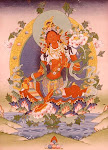A last lesson in impermanence
"Thousands attend the last rites of the Nyingmapa master
Purjang : Dungse Thinley Norbu Rinpoche.
The significance of impermanence became Holiness Dungse Thinley Norbu Rinpoche’s last teaching to more than 15,000 devotees gathered for the purjang (cremation) in Lango, Paro on March 3. Watch video
“It’s just an example of impermanence shown by an enlightened master,” a monk, Dorji Wangchuk, from Mysore Namdroling Ngajur Nyingma institute, who came to get Rinpoche’s last blessings, said. “For Rinpoche, death is like changing his old clothes; but to us it’s a reminder to realize the uncertainty of life.”
Thousands had camped in Dagophu gompa two to three days before the purjang to pay their last homage.
In the early hours of the purjang, coinciding with the 10th day of first Bhutanese month, the purkhang premises (crematorium) was already filled, and many sat on rocks, under pine trees, and the facing hillslope. The purkhang stood on an intricately carved dais, with a traditional roof over it, held by four pillars painted in Bhutanese design.
The purjang ceremony began at four in the morning, with the kudung housed in a small temple. The sound of religious instruments, especially drums and ritual bells, filled the entire Dagophu village in the silent and chilly morning.
Facing the purkhang from the west, the reincarnation of His Holiness Dudjom Jigdral Yeshe Dorji, Sangay Pema Rinpoche, performed the Dorji Sempai lachoepa (Vajrasattava).
Facing the purkhang from the north, south and east, the reincarnation of Lam Sonam Zangpo, the reincarnation of Bartsam Lam, Pema Wangchen, and Yonphula Rinpoche Jigme Tenzin performed throema tshogkhor (offering), surrounded by thousands of throema practitioners, all chanting with ritual drums and bells.
At around 8:30am, as the ceremony offering continued, the kudung was escorted to the purkhang in a religious ceremonial procession, led by their eminences Dzongsar Jamyang Khyentse Rinpoche and Dungzin Garab Rinpoche. Devotees folded their hands, closed their eyes, and made prostrations.
The kudung was dressed as Long Kui Choe (Sambhogakaya), one of the three manifested bodies of Buddha. The head was dressed with the tshuktor (hair-knot), rignga (five crowns of Buddha) right below the hair-knot, thug gen (precious ornaments like coral and cat’s eye) adorned on the neck, drilbu (ritual bell) on the left hand, and dorji (Vajra) on the right hand, with special bracelets worn on both the arms. The legs were in dorji kultung (meditation posture). The lower part of the body was adorned with white silk, and upper torso dressed in fine brocade. The face was painted with gold to the appearance of Dorji Sampa (Vajrasattva), said sculptor Karma, who was involved in the painting.
The kudung was placed in the purkhang in Sambhogakaya and visualised as the Kilkhor (mandala). Sangay Pema Rinpoche, who led the main ceremony, was also dressed in Sambhogakaya, with special bone ornaments worn across the shoulder.
As Khandro Kuenzang lit the fire, facing the purkhang, the two daughters of Dungse Rinpoche, Pema Choki and Kesang Wangmo, from right and left, accompanied by his younger son Ugyen Namgyel, lit the kudung from the other directions, while the two elder sons, Dzongsar Jamyang Khyentse and Dungzin Garab Rinpoche, offered various objects in the fire ceremony.
Devotees offered khadars, seeking blessings of the kudung, as the smoke touched the roof of the purkhang. While Bhutanese devotees made up most of the people attending the purjang, there were also disciples and students from America, Europe and Asia. More than a hundred lams and trulkus from outside were also there.
Their Majesties the Queen Mothers, Ashi Tshering Yangdon Wangchuck and Ashi Sangay Choden Wangchuck, were present. The government was represented by the prime minister, Jigmi Y Thinley, and cabinet ministers.
Dungse Thinley Norbu Rinpoche, who passed away on December 27 in the United States, was a primary holder of the Dudjom Tersar lineage, a collective name for the large collection of terma teachings revealed by his late father.
Born in 1931 in Kongpo, Tibet, to His Holiness Dudjom Jigdral Yeshe Dorji and Sangyum Kusho Tseten Yudron, Dungse Rinpoche was the chief architect of the Thimphu Memorial chorten, which he built under the guidance of his father.
Many devotees circumbulated the purkhang all day long. Some prayed in silence, while other chanted in groups for the swift re-birth of Dungse Rinpoche to continue his turning the dharma wheel.
The purthel (ashes) and kuri (bones) will be collected after five days and made into tsa tsa (miniature conical figure) offerings, tsampa Sonam of Bartsham said."
By Tenzin Namgyel, Paro
- - - from Kuensel online
Wednesday, March 07, 2012
Subscribe to:
Post Comments (Atom)


No comments:
Post a Comment